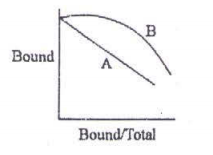 Multiple Choice Questions
Multiple Choice QuestionsWhich of the following is the correct decreasing order for the rate of decomposition of litter constituents?
Hemicellulose, cellulose, lignin, phenol
Cellulose, hemicellulose, phenol, lignin
Hemicellulose, cellulose, phenol, lignin
Lignin, phenol, hemicellulose, cellulose
The following is the amino acid sequence of a part of a protein encoded by gene 'X'
...Phe Leu Val Pro Ser Tyr Cys...
A mutant for gene 'X' is isolated following treatment with a mutagen. The amino acid sequence of the same region encoded by the mutant gene is as follows:
....Phe Leu Phe Arg Arg Ile....
Which of the following mutagens is most likely to have been used?
5-bromouracil
2-amino-purine
Ethyl methanesulfonate
Acridine orange
In order to precipitate a particular protein by its specific antiserum, it was found that the protein formed cross-linked lattice with specific polyclonal antiserum but failed to precipitate with specific monoclonal antiserum. Which of the following would accurately justify the reason for this behavior?
The protein has multiple copies of the same epitope specific for the monoclonal antibody.
The protein has multiple distinct epitopes but each has a single copy.
There is total absence of epitopes in the protein.
The protein has multiple copies of different epitopes.
Enzyme parameters of four isozymes is given below:
| Isozyme | Km micromolar | Vmax |
| A | 0.1 | 15 |
| B | 1.5 | 45 |
| C | 4.0 | 100 |
| D | 0.01 | 10 |
These isozymes are localized in different tissues. In liver the substrate concentration is 0.2 micromolar.
The liver isozyme is likely to be
A
B
C
D
Binding of two ligands to their binding proteins was investigated. Following binding isotherms were obtained.

Which of the following statements is correct?
A is obtained with an oligomeric protein and B is obtained with a monomeric protein.
B is obtained with protein with positive cooperativity.
A and B were obtained by the same protein at two different temperatures.
The profile B is not possible.
Two homologous proteins were isolated from a psychrophile (P) and a thermophile (T). The purified proteins were subjected to denaturation, protease digestion and circular dichroism (CD). Following observations were made :
A. The CD spectra of P and T proteins are identical.
B. Their amino acid composition is 95% identical.
C. T and P are equally susceptible to proteolysis in the presence or absenceof reducing agent.
D. T has higher midpoint of thermal denaturation than P.
The reason for enhanced stability in T is due to
Altered secondary structure
Increased number of disulfides in T.
Increase in water of hydration.
Increase in number of salt bridges
Acetyl-(Ala)18-CONH2 exists in α-helical conformation in solution. Most of the backbone dihedral angles (Φ, ψ) will be
-60°, -30°
60°, 30°
-60°, -30°(50%) and 60°, 30° (50%)
-80°, 120°
The lifetime of a peptide bond in proteins is very large (∼1000 years). Which statement below is INCORRECT with respect to the stability of the peptide bond?
The free energy of hydrolysis is negative
The free energy of hydrolysis is positive and large.
The energy barrier to be crossed to go to the hydrolyzed state is large.
The peptide bond can be hydrolyzed by 6N HCl at 100°C.
Two 18-residue helical peptides A and B are enantiomers. They can be distinguished by
recording their MALDI mass spectrum.
hydrolysis followed by amino acid analysis.
sequencing by Edman's method.
examining their circular dichroism spectra
5-Bromouracil is a base analog that can cause mutation when incorporated into DNA. Which of the following is the most likely change that 5-Bromouracil induces:
T:A to C:G
T:A to A:T
G:C to T:A
C:G to A:T
